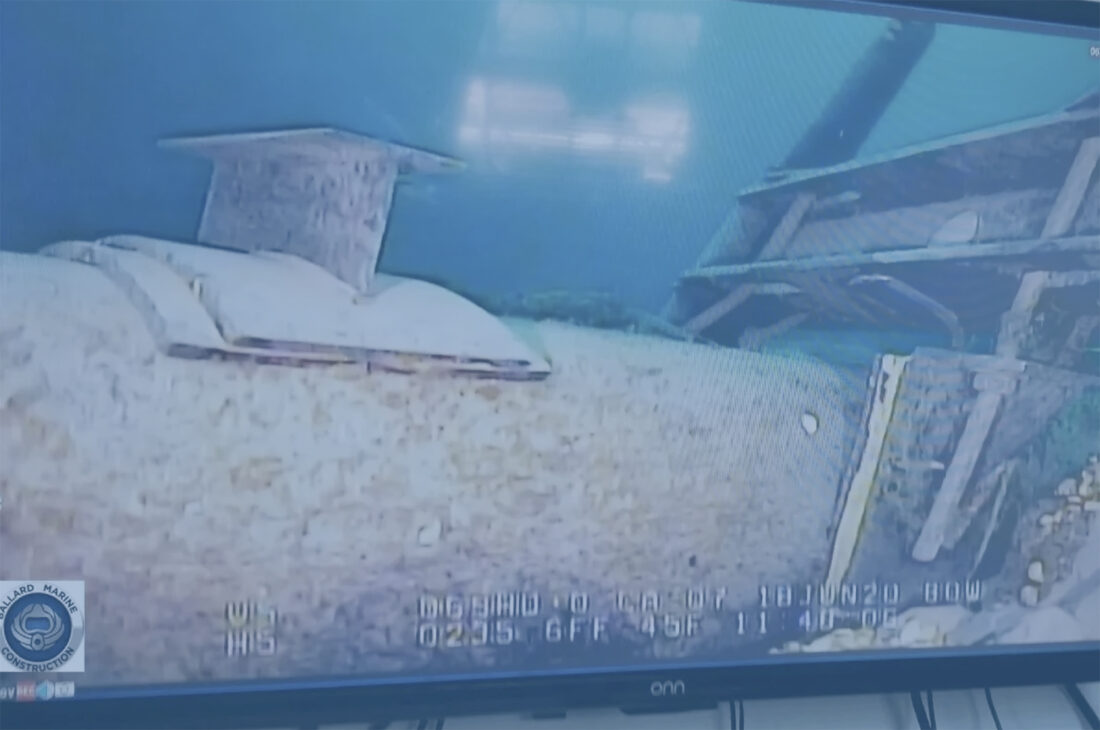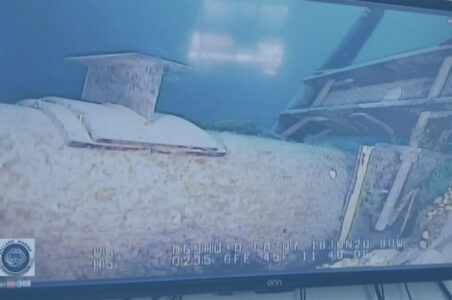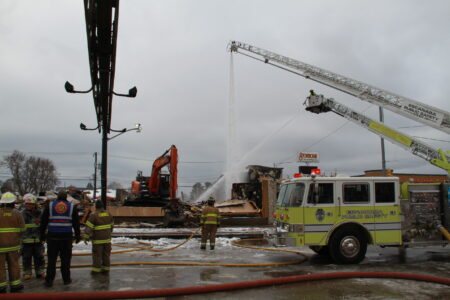Feds eye new Line 5 option: No tunnel, horizontal drilling

A portion of the Enbridge Inc. Line 5 pipeline under the Straits of Mackinac. (Photo via Bridge Michigan)
(This story was originally published by Bridge Michigan, a nonprofit and nonpartisan news organization. Visit the newsroom online: bridgemi.com.)
With limited public notice, the U.S. Army Corps of Engineers has placed a new option on the table for the future of the Line 5 pipeline as it prepares to make a high-profile permitting decision about the pipeline’s fate.
Rather than replacing the 4-mile stretch of Line 5 that currently rests in the open water of the Straits of Mackinac with a new span buried in a 21-foot-wide concrete tunnel beneath the lakebed, Enbridge could potentially use “horizontal directional drilling” to place the pipeline into a much narrower borehole with no tunnel.
The Corps has spent years considering whether to issue key permits Enbridge needs to begin the tunnel project, a process that involves weighing alternative options.
The new alternative comes months after the Corps first issued a so-called environmental impact statement expressing few major concerns about the tunnel plan that Enbridge pitched years ago as the best option for eliminating the chance that Line 5 could cause an oil spill in the Straits.
On Nov. 12, the Corps posted a “supplemental” impact statement describing the horizontal drilling option to a federal website, initiating a public comment window that closes Dec. 5.
The agency has scheduled an online public comment session for Dec. 3 and is also accepting written comments.
The Corps did not issue a widely distributed news release alerting the media to the new developments — an atypical move for the agency, particularly given the deep public interest that has surrounded the Line 5 replacement effort.
In a 2018 report to the state of Michigan, Enbridge concluded that horizontal drilling was not a viable option for drilling through a 4-mile section of hard subsurface rock beneath the Straits.
According to the Corps’ new review, sometime after the agency’s May review of the tunnel plan, Enbridge “provided USACE with information” indicating that horizontal drilling is now “technically feasible due to advances in technology.”
Rather than encasing the pipeline in a tunnel, the process would involve drilling a much narrower hole that would be “a minimum of 42 inches,” according to the Corps. The 30-inch-wide pipeline would be assembled on land, requiring a 4-mile-long by 80-foot-wide assembly area either north or south of the Straits, and then pulled through the hole. Construction would take about 2 years.
Spokespeople for the Corps and Enbridge did not immediately answer phone messages left by Bridge Michigan, nor emailed questions about how the new option came about and when Enbridge provided the Corps with information indicating it was a technically feasible solution to longstanding safety concerns surrounding the existing dual-span pipeline in the Straits.
In an emailed statement, Enbridge spokesperson Ryan Duffy said the Corps’ review of the horizontal drilling option is “not something we pitched” and “doesn’t change anything we are planning to do.”
“We are planning to build the tunnel,” Duffy said. “Our Army Corps application is for the tunnel.”
Corps officials did not respond to questions from Bridge about the agency’s decision to issue the supplemental environmental impact statement and start a public comment period without issuing a news release to alert the public.
In comparison, the Corp’s original environmental impact statement was accompanied by a widely distributed news release.
Environmentalists blasted the late-stage addition of a new option as a “bait and switch” committed by Enbridge and the Corps. They questioned whether the company could safely complete a horizontal drilling project in the Straits, citing a history of drilling fluid leaks during other Enbridge drilling projects.
“Enbridge and the Army Corps are realizing that the original tunnel proposal is a risky endeavor that would threaten taxpayers and the environment,” said Sean McBrearty, campaign coordinator of the Oil & Water Don’t Mix coalition.
“Now, after moving the goalposts and speeding up the process for reviewing the tunnel proposal after intervention from the Trump administration, they’re now proposing a brand new plan. Why would we trust this new proposal any more than the original one?”
A publicly available timeline for the Corps’ decision on the agency’s website has also been updated, pushing an anticipated final permitting decision to next spring. The Corps had previously said it expected to issue a decision this fall.
The addition of a potential new option for Line 5 is the latest development in a yearslong battle over the Canadian-owned oil pipeline’s fate.
In response to growing public concern that the aging pipes could rupture and cause a catastrophic oil spill in the Straits, Enbridge struck an agreement with then-Gov. Rick Snyder’s administration to move the pipeline into a concrete-lined tunnel bored deep underground.
Originally advertised as a $500 million project that might finish by 2024, construction has yet to start and costs are now likely in the billions.
Meanwhile, Enbridge and Attorney General Dana Nessel are locked in legal battle as Nessel pushes to shut down the existing pipelines, contending they pose an imminent threat to the Great Lakes.







